
|
|
 |
|
|
|
|
|
|
|
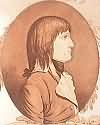 | Prints of |  |
![]()
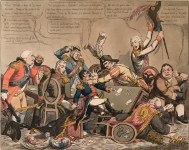
Ansell. "Political Quadrille - the Game Up. Plate 2d." London: Walker, August 1808. Etching. Original hand color. 12 1/8 x 14 5/8. Minor wear at edges; expertly repaired tear through upper right corner. Else, very good condition. George 11015.
In this skillful caricature, the artist arranges eight European nations in a farcical card game (Quadrille, a four-handed version of the popular Ombre). As George III looks on from the edge, Tsar Alexander (marked by the bear on his seat-back) re-evaluates the alliance he formed with Napoleon at Tilsit (July 1807). His ally is thrashed by an angry Spanish patriot, who demands the return of his king, Ferdinand VII, who had been ousted when Napoleon installed his brother Joseph on the Spanish throne (June 1808). Meanwhile, Prussian King Frederick William III (in blue coat), still smarting from defeats suffered from France in 1806, determines to take advantage of the fray, as does Austrian Emperor Francis II (in white coat), who had recently been dethroned as Holy Roman Emperor by Napoleon's formation of the Confederation of the Rhine (July 1806). At the right edge of the scene, Pope Pius VII remains soundly dominated by Napoleon, whose boot rests on the upturned symbol of the Catholic Church. Indeed, a few years after this caricature, Napoleon would arrest the Holy Father for excommunicating the "despoilers of the church" (May-July 1809). The final member of Napoleon's table, a squat Dutchman with a pipe moves to leave the game, removing himself from the struggle. Though Napoleon imposed his brother Louis as ruler of Holland, the little nation was not entirely ungrateful - the alternative was complete annexation by France, and their new French king actually managed some beneficial public works projects during his reign. This savvy Dutchman decides it in his best interest, then, to avoid the fracas altogether. All in all, this is a masterful satirical interpretation of Europe's tangled political situation.
*Note: Broadley credits this to an artist named only as "Ansell." George identifies no artist. $1,450
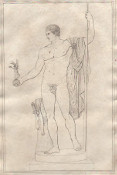
"Canova's Statue of Napoleon." From The Analectic Magazine. Philadelphia: October 1820. 7 1/2 x 5. Line engraving. Very good condition.
In 1812, Philadelphia bookseller and publisher Moses Thomas purchased a monthly magazine entitled Select Reviews, engaged Washington Irving as editor, and renamed the publication The Analectic Magazine. Irving, his brother-in-law J. K. Paulding, Gulian C. Verplanck and, later, Thomas Isaac Wharton wrote much of the material, which concentrated on literary reviews, articles on travel and science, biographies of naval heroes, and reprints of selections from British periodicals. Illustration "was one of the magazine's chief distinctions. Not only were there the usual engravings on copper, but some of the earliest magazine experiments in lithography and wood engraving appeared here. The plates were chiefly portraits, though some other subjects were used." (Mott, A History of American Magazines) $175
"A Eux La Honte, A Lui La Gloire." Paris: Dopter, undated, but ca. 1821. Aquatint by Roenuld. 7 3/4 x 11 1/2. Some light discoloration in margins. Very good condition.
A fascinating 'apotheosis' print of Napoleon issued shortly after his death on May 5, 1821. Napoleon is shown being lead up to heaven by a trumpet blowing goddess, while his troops and officers praise him with laurel branches. To the left is shown some mourners on St. Helena. Below is a elegy to the great man. $275
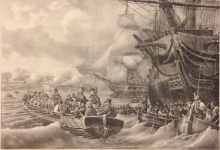
After Gudin. "Debarquement à l'Ile de Malte." [Bonaparte landing on Malta]. 12 1/4 x 17 3/4 (image). Paris: ca. 1830. Lithograph by C. Motte. Very good condition.
A dramatic lithograph showing Napoleon landing on Malta in 1798. The island of Malta was an important strategic stronghold in the Mediterranean Sea and Napoleon knew that controlling it would help French fleet, both in the region and his desire to conquer Egypt and India. He captured the island but the Maltese revolted and remaining French forces were forced to surrender when the British intervened. Thus began the start of a century and half of British rule of the island. $325
"Réception Des Cendres De L'Empereur Napoléon." Paris, undated but ca. 1840. Lithograph. 8 1/8 x 12. Original hand color. Some wear and light smudging in margins. Overall, very good condition.
In 1840, Louis Phillippe ordered that the body of Napoleon be moved from St. Helena to the Invalides in Paris. This French lithograph shows the casket being turned over to the naval guard of honor before being sent out to the ship for transport. $225
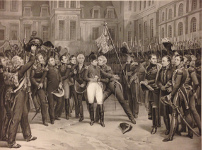
After Horace Vernet. "Adieux de Fontainebleau. (20 April 1814)." Paris: Goupil & Vibert, ca. 1860. 19 1/4 x 25 1/2. Aquatint by Jean-Pierre Marie Jazet. Very good condition.
After his failed invasion of Russia and defeat by the Allies, Napoleon abdicated and bid farewell to the remnants of his faithful officers in the courtyard at Fontainebleau before being sent into exile on the island of Elba. The emotional speech he gave to his Old Guard:
Soldiers of my Old Guard: I bid you farewell. For twenty years I have constantly accompanied you on the road to honor and glory.$750
In these latter times, as in the days of our prosperity, you have invariably been models of courage and fidelity. With men
such as you our cause could not be lost; but the war would have been interminable; it would have been civil war, and that would
have entailed deeper misfortunes on France. I have sacrificed all of my interests to those of the country. I go, but you, my
friends, will continue to serve France. Her happiness was my only thought. It will still be the object of my wishes. Do not
regret my fate; if I have consented to survive, it is to serve your glory. I intend to write the history of the great
achievements we have performed together. Adieu, my friends. Would I could press you all to my heart.
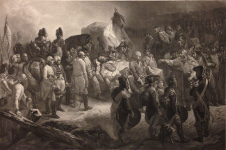
After F. Bouchot. "Funérailles de Marceau." Paris: F Dubreuil ca. 1860. 20 x 30 (image) plus margins. Mezzotint. Very good condition.
François Séverin Marceau-Desgraviers was a French general of the Revolutionary Wars. Born in Chartres in 1769, Marceau enlisted in the French Army at age 16. While in Paris, he participated in the storming of the Bastille on July 14, 1789. Resigning from the Army, he joined the National Guard and was eventually promoted to Lieutenant Colonel of a French Revolutionary Army battalion. In 1793, Marceau distinguished himself in battle against the Royalist forces by rescuing an important Revolutionary representative. He was promoted through the ranks after winning several victories and reached the rank of General of the Division upon his death in 1796, when he was wounded in battle during the unsuccessful invasion of Germany. His ashes were eventually interred in the Pantheon in Paris in 1889. $575

Charles Auguste de Steuben 1788-1856. "Napoleon's Return from the Isle of Elba, March 7th, 1815." Most likely published in London by G. Dawe, ca. 1875. 16 3/4 x 21 1/2 (image) plus margins. Engraved by George Sanders. Original hand color. Some small scattered spotting in image in area of Napoleon's raised hand. Small water stain bottom right margin corner not affecting image. Else, very good condition. $500
A dramatic, striking and colorful print showing Napoleon greeting French soldiers and citizens after his escape from the island of Elba.

[Napoleon.] Chicago: Werner Co., ca. 1880-90. Tinted lithograph. 24 x 18 1/4. Some chipping at edges of margins, but image very good.
A large, handsome portrait of Napoleon issued by a Chicago firm near the end of the nineteenth century. $375
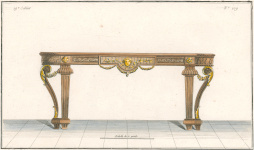
J.-Fr. Boucher. Plate 109. [Ornate Table]. From Livre de Meubles.... Paris, ca. 1780. Folio. 7 1/4 x 12 3/8 (image). Engraving. Early hand color. Excellent condition. $250
We have more prints from this series. Please call or email for more information.
In this comprehensive snapshot of French design, Boucher offers decorators, architects, and cabinetmakers a print source for the latest designs of the 1780s. With features ranging from garden gates to candlesticks, from library cases to bathtubs, each group of these prints (sold by subscription in cahiers) showcased the many styles of the period: English, Rhineish, Italian, Roman, and, of course, French. In order to produce the highly-coordinated rooms demanded by fashionable customers, craftsmen (including cabinetmakers, metalsmiths, architects, and ceramicists) needed a common design source. Books like Boucher's provided necessary, cutting-edge information to those who made and purchased decorative arts in the eighteenth century.
![]()
For further information, please contact:

![]()
106 E. Lancaster Avenue, Lower Level
Wayne, PA 19087 USA
610.808.6165
PhilaPrint@PhilaPrintShop.com ![]()
©The Philadelphia Print Shop. Last updated July 14, 2021